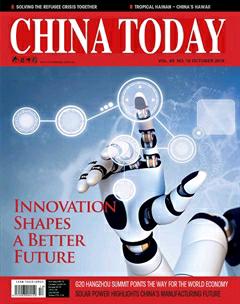Forging Ahead Together
Forging Ahead Together
The 2016 G20 Hangzhou Summit helped develop new concepts and inject new stimulus into the growth of the world economy. In order to realize the full potential of the summit, however, it is vital that countries implement the consensus reached at the meeting. China endeavors to enhance development of the world economy by proactively applying new concepts and bringing to the table its successful experience of economic growth.
This year “green finance” was added to the summit agenda as a common goal for all participating countries. The International Green Finance Forum, unveiled in Shanghai directly after the G20 Hangzhou Summit, encouraged greener investment based on the green finance development policies recently launched by the Chinese government. These new policies map out the use of such financial tools as green credit, green bonds, green funds,green insurance, and carbon finance.
The necessity of breaking new ground to stimulate growth was highlighted at this year’s meeting. In order to underscore the value of knowledge, China has introduced new distribution policies,and begun to establish a salary system and income growth mechanism for intellectual property. For the first time G20 members have acknowledged the importance of over-arching structural reform and endorsed nine priority areas and 48 guiding principles within structural reform policy-making. Promoting openness in trade and investment is the top priority. Pilot free trade zones(FTZ) in China are fast expanding. Seven new provinces recently ratified FTZs that are expected to benefit enterprises both at home and abroad.
G20 members are closely watching which measures China will take to allow the market full play in resource allocation - one of the key components of ongoing economic reforms in China. The government has also confirmed ownership, contracting rights,and management rights of land in rural areas. Land contracting rights are now better protected, and farmers are endowed with relatively flexible land management rights. They can hence expect more stable prospects for land usage.
The G20 meeting is an opportunity for dialogue, and a mechanism serving as a platform to mitigate bilateral or multilateral conflicts and achieve common understanding. At the meeting,Chinese President Xi Jinping commented on this new concept of international relations: “As members of the global village, we need to cultivate the awareness of a community of shared future for humankind. Partnership is the most valuable asset of the G20 and the choice of all countries as they rise together to meet global challenges. We need to seek common ground while shelving and narrowing differences in an effort to build a new type of international relations featuring win-win cooperation.” He went on to say, “The world will be a better place only when everyone is better off.”
Bilateral meetings during the summit have shown China’s close connections with other countries. The new style of partnership between China and the United States is developing steadily. The comprehensive strategic partnership between China and Russia works effectively. China’s strategic partnership with the EU is growing, and China’s cooperation with emerging economies and the developing world is flourishing. The new strategic partnership between China and Africa, moreover, is consistently enriching. All these achievements embody China’s philosophy of building a community of shared future for humankind.
This year’s summit involved the biggest number of developing countries in history - not only increasing the representation and voice of the developing world, but also revealing that as the world economy grows it provides developing countries with more opportunities.
The Association of Southeast Asian Nations (ASEAN) and East Asia Summits held in Vientiane, Laos after the G20 Hangzhou Summit have further strengthened the building of an ASEAN Community and East Asian Community. It was the first official meeting for leaders of ASEAN nations since the community was established at the end of last year. The theme of this year’s meeting - making the ASEAN Community Vision 2025 a reality - has kindled more specific action plans.
The relationship between China and ASEAN has evolved from one of growth to maturity. Chinese Premier Li Keqiang attributed the successful bilateral relations to mutual trust, genuine friendship, common interests, and harmony. At the meeting, Li gave a frank presentation about where China stands on the South China Sea issue and put forward five proposals in terms of deepening bilateral cooperation, which received positive responses from leaders of ASEAN nations and Southeast Asian peoples. Outcomes achieved at the meetings have laid a foundation for increasing economic collaboration and the capacity for cooperation under the framework of the Belt and Road Initiative. These achievements constitute an ever-strengthening mututal trust between the two sides as regards politics and security, which guarantees closer ties and a shared future for China and the ASEAN community.
All humankind is in the same boat. When navigating rough waters it is vital that we all act in the spirit of solidarity. We may then brave the storm and forge steadily ahead.

